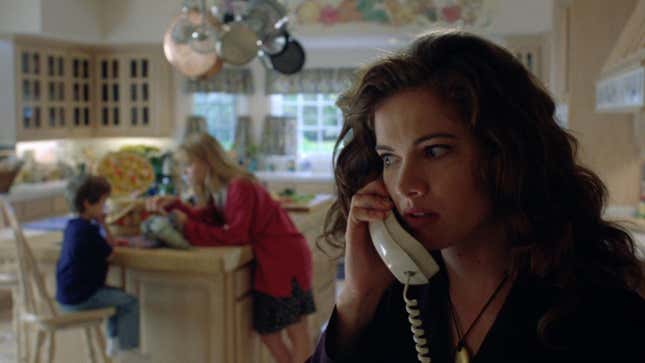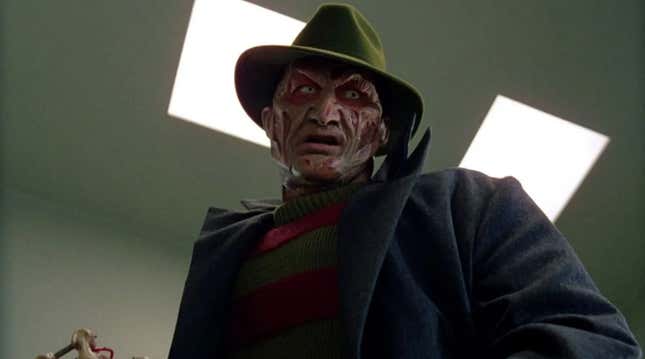The year is 1994. I head to the theater, buy a ticket for Wes Craven’s New Nightmare, and I’m not ready for what happens next. The year is 2023. I flip over to Max, press play on Wes Craven’s New Nightmare, and I’m still not ready for what happens next.
A lot has changed in the nearly 30 years since Wes Craven took his last spin with his best-known character, Freddy Krueger, in the ultra-meta film New Nightmare. We’ve gotten older. Some of us have gotten wiser. Craven passed. The world has become a smaller place due to the explosion of the internet. And, most importantly in this case, self-reference has become a much more common way of expressing an idea or presenting a story.
In 1994, when Craven wrote and directed his final Freddy film, the idea of a meta-narrative was much less prevalent. It was out there for sure, in the previous year’s Last Action Hero and going all the way back to the 1960s and 1970s, when film icons like Federico Fellini and Orson Welles experimented with it in their work. This wasn’t a new thing, but it was very rarely a successful thing, especially at the time. With a few exceptions, or unless you were Mel Brooks, very few of those films resonated with large audiences. So despite New Nightmare capping off a nearly half-a-billion dollar franchise, it was by far the least financially successful of the series, grossing under $20 million globally.
The message was clear. Audiences didn’t care. And watching the film today, especially not having seen it since its original release, it’s honestly not that surprising. Craven is doing things that probably felt to some audiences like they were watching a movie in another language without subtitles. You have to think about what’s happening in multiple realities. You have to be fairly well-versed in the on and off-screen history of the Nightmare franchise. A knowledge of the filmmaking process is also a bonus—and then, on top of all that, it has to work as something that’s ultimately scary and exciting too. The end result is not entirely successful but remains a fascinating slice of horror history that feels like an almost necessary bridge to what came next in the genre.
To briefly recap, New Nightmare takes place in our world, where actress Heather Langenkamp, playing herself, is famous for playing Nancy in the ultra-popular A Nightmare on Elm Street series, which she was. Heather starts having all-too-real dreams about her former co-star Freddy, which just so happens to coincide with Wes Craven, playing himself, writing one final Nightmare movie for Heather. Things go off the rails from there with Craven explaining Freddy is the manifestation of some ancient evil that is now coming back via storytelling and the only way to stop him is to make a movie, which at the very end we learn is the movie we’ve been watching the whole time. Thirty-year-old spoiler alert.

Even watching the film today, it’s all a bit much. The idea is super inventive and ripe for exploration but is also near-obsessed with being grounded in reality, which it does mostly by casting the principles as themselves (not just Langenkamp and Craven, but Robert Englund, who plays “Robert Englund” as well as Freddy; the head of New Line Cinema, Bob Shaye; and John Saxon, who played Nancy’s father in the original film). Then, Craven’s story about story becomes a mirror on the audience: our appetite for franchises, our adoration of celebrity, and our fascination with terror. It plays as a man conflicted about his creation and eager to explore its ramifications. The film never quite comes to a consensus on what it wants to say about any of that, but it gets you thinking about all of it, and maybe that’s enough.
Or, in 1994, maybe it was too much. What happens in New Nightmare as a result of this twisty, turny, self-aware narrative is that the Freddy we all know and love is all but absent for the majority of the film. He appears in flashes, and much more prominently at the end, but he himself is “real” and not that much fun. In fact, this Freddy is much more in line with where Craven wanted to see the character go, getting darker and scarier as opposed to the goofier and funnier way he went in later sequels. So there’s a distinct, borderline detrimental clash between expectation and intention. Some of that does get splattered over with the film’s effects and gore, but even that is dialed back considerably and a little lost under the cloud of the story.

As the movie ended I found myself in awe at its ambition. Thinking about how Craven probably, as the movie suggested, was getting pressure to bring Freddy back even though the previous film was called “Freddy’s Dead,” and did so only under these most extreme of circumstances. I then thought about the film Craven followed New Nightmare with—not Vampire in Brooklyn, though that was the immediate next film. The one after that: Scream, written by Kevin Williamson. Scream too (but maybe not Scream 2) is a smart, meta-horror movie without all the extraneous layers. Everything is more focused and streamlined while also rewarding you for being a film and horror fan. Which, of course, then resulted in Scream becoming one of the most influential and successful franchises in the genre.
This is all to say that while Wes Craven’s New Nightmare is certainly not the best Nightmare sequel (COUGH Dream Warriors COUGH), it’s definitely not the worst either, which its box office at the time seems to suggest. Instead, the film feels underrated and underappreciated more than anything else. Its fans are certainly out there though and I’m not the first person to have this epiphany about its significance to Craven and horror. But somehow, rediscovering it on a random evening in October felt like the exact right thing to do at the exact right time. Almost as if Craven and Freddy planned it that way.
Wes Craven’s New Nightmare is streaming on Max.
Want more io9 news? Check out when to expect the latest Marvel, Star Wars, and Star Trek releases, what’s next for the DC Universe on film and TV, and everything you need to know about the future of Doctor Who.
Trending Products

Cooler Master MasterBox Q300L Micro-ATX Tower with Magnetic Design Dust Filter, Transparent Acrylic Side Panel, Adjustable I/O & Fully Ventilated Airflow, Black (MCB-Q300L-KANN-S00)

ASUS TUF Gaming GT301 ZAKU II Edition ATX mid-Tower Compact case with Tempered Glass Side Panel, Honeycomb Front Panel, 120mm Aura Addressable RGB Fan, Headphone Hanger,360mm Radiator, Gundam Edition

ASUS TUF Gaming GT501 Mid-Tower Computer Case for up to EATX Motherboards with USB 3.0 Front Panel Cases GT501/GRY/WITH Handle

be quiet! Pure Base 500DX ATX Mid Tower PC case | ARGB | 3 Pre-Installed Pure Wings 2 Fans | Tempered Glass Window | Black | BGW37

ASUS ROG Strix Helios GX601 White Edition RGB Mid-Tower Computer Case for ATX/EATX Motherboards with tempered glass, aluminum frame, GPU braces, 420mm radiator support and Aura Sync









